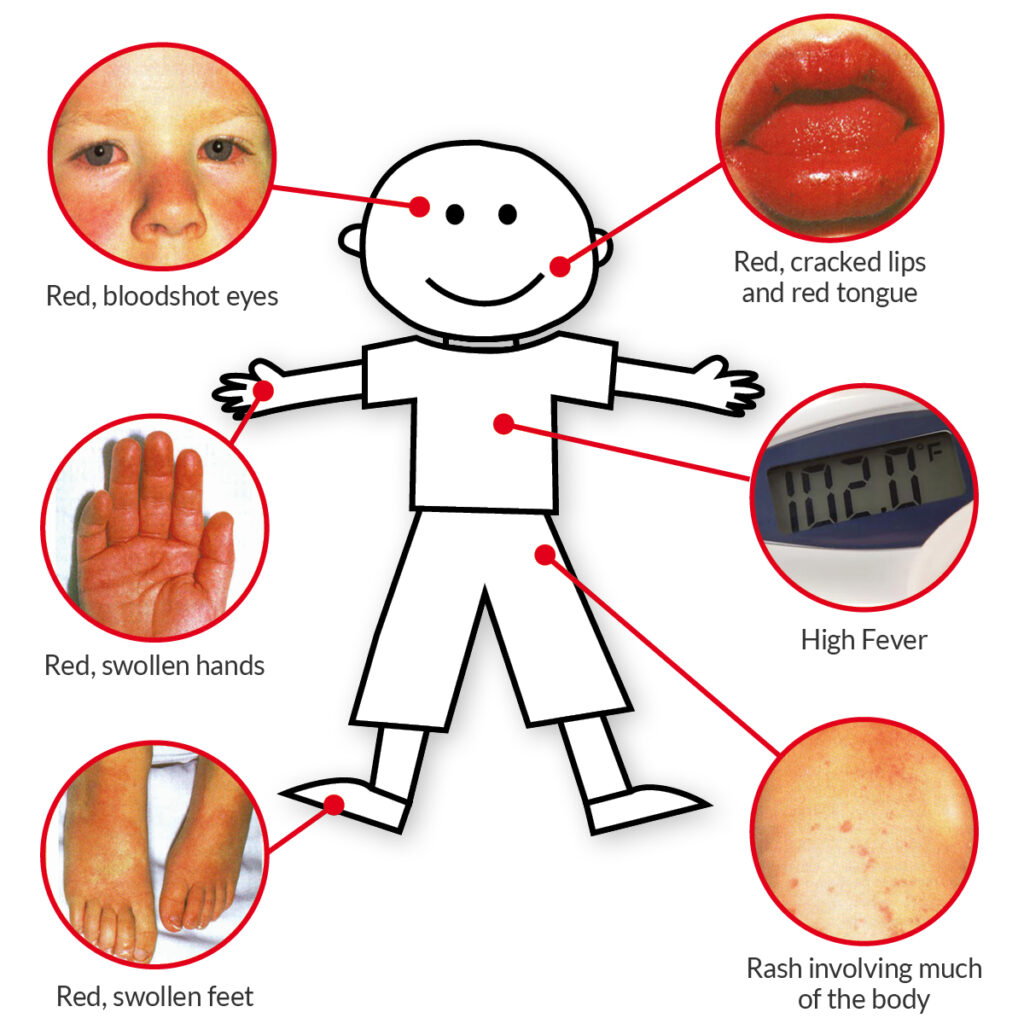What is Kawasaki Disease? Kawasaki Disease (KD), also known as mucocutaneous lymph node syndrome, is a rare but serious condition that primarily affects children under the age of five. It causes inflammation in the walls of medium-sized arteries throughout the body, including the coronary arteries, which supply blood to the heart muscle.
Causes of Kawasaki Disease: The exact cause of Kawasaki Disease is unknown. However, it is believed to be triggered by an abnormal immune response to an unknown infectious agent in genetically predisposed individuals.
Symptoms of Kawasaki Disease:
- High Fever: Prolonged fever lasting for five days or more is the hallmark symptom of Kawasaki Disease.
- Rash: A rash may appear on the trunk, limbs, and genital area, often resembling a sunburn or measles.
- Swollen Lymph Nodes: Enlargement of lymph nodes, particularly in the neck area.
- Red Eyes: Bloodshot eyes without discharge and without crusting.
- Strawberry Tongue: The tongue may become red and swollen with prominent papillae, giving it a strawberry-like appearance.
- Swollen Hands and Feet: Swelling and redness of the hands and feet, followed by peeling of the skin in the later stages.
- Irritability: Children may be irritable, fussy, or lethargic.
- Joint Pain: Joint pain and swelling, often affecting the knees and other large joints.
Diagnosis of Kawasaki Disease:
- Physical Examination: Healthcare providers may diagnose Kawasaki Disease based on the characteristic symptoms observed during a physical examination.
- Blood Tests: Blood tests may reveal elevated levels of inflammatory markers such as C-reactive protein (CRP) and erythrocyte sedimentation rate (ESR).
- Echocardiogram: An echocardiogram is performed to assess the function of the heart and detect any abnormalities in the coronary arteries.
- Other Tests: Additional tests, such as a chest X-ray or electrocardiogram (ECG), may be ordered to evaluate heart and lung function.
Treatment of Kawasaki Disease:
- Intravenous Immunoglobulin (IVIG): Administration of high-dose IVIG is the primary treatment for Kawasaki Disease, usually given along with aspirin.
- Aspirin Therapy: Aspirin is given in high doses initially to reduce fever and inflammation. Once the fever resolves, the dose is lowered to prevent blood clot formation.
- Supportive Care: Supportive measures, such as fever management, hydration, and pain relief, may be provided to alleviate symptoms and prevent complications.
- Follow-Up Care: Regular follow-up appointments with a pediatric cardiologist are essential to monitor cardiac function and detect any coronary artery abnormalities.
Complications of Kawasaki Disease:
- Coronary Artery Aneurysms: The most serious complication of Kawasaki Disease is the development of coronary artery aneurysms, which can lead to heart attacks or sudden death if left untreated.
- Myocarditis: Inflammation of the heart muscle (myocarditis) can occur, affecting heart function.
- Arrhythmias: Irregular heart rhythms (arrhythmias) may develop, requiring monitoring and treatment.
- Heart Valve Abnormalities: Damage to heart valves may occur, affecting blood flow within the heart.
Conclusion: Kawasaki Disease is a rare but potentially serious condition that primarily affects young children. Early recognition and prompt treatment with IVIG and aspirin can significantly reduce the risk of coronary artery complications and improve outcomes. Parents should be vigilant for the symptoms of Kawasaki Disease and seek medical attention promptly if they suspect their child may be affected. With appropriate treatment and follow-up care, most children with Kawasaki Disease recover fully without long-term complications.




